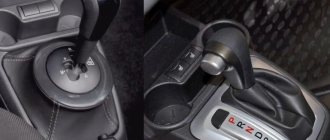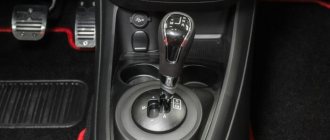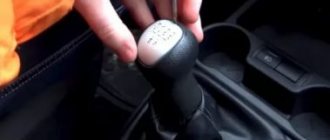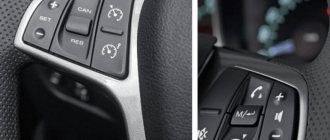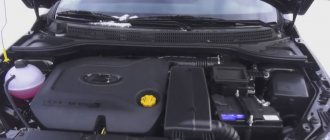The robotic gearbox is a joint development of AvtoVAZ together with the German company zf.
How does a “robot” work?
The robot is still the same 2180 gearbox with a cable drive with redesigned mounts, but in addition with an installed automatic shift mechanism, which was developed by the German company ZF. The automatic “actuator” mechanism depresses the clutch for you, puts the gear in gear, and releases the clutch.
The robot selector has the following positions:
N – neutral
R – reverse gear
M – manual switching mode
Vesta robot control diagram
In fact about the robot: Is it worth buying a car with a Robot?
If you are interested in the question of whether it is worth buying a robot, we will tell you: sign up for a TEST DRIVE, because it is free. Only by experiencing the robot’s operation yourself will you be able to understand whether it is suitable for you or not. If it doesn’t fit, then a manual transmission package is waiting for you.
AvtoVAZ says that the gearbox is suitable for everyone; AMT has 20 different switching algorithms. But this is not entirely true.
A little from myself: If you have a harsh character and you need appropriate behavior from a car, a robot is not for you. The robot is designed for calm, leisurely driving at medium speeds with smooth shifts and saving fuel and the clutch disc. And the question immediately arises of how this transmission will perform on Vesta Sport: how much the settings will be changed, whether sportiness will appear, etc.
Design features and device of the JR5 Lada Vesta gearbox
The domestic robot largely copies the boxes of the German concern ZF. The AMT actuator consists of:
- clutch activation actuator;
- speed change actuator;
- clutch forks;
- backstage for controlling gears inside the car;
- input shaft speed sensor.
The design of a typical robot with electric drive and a single clutch disc. In Europe and Asia, such technology was abandoned five years ago in favor of preselective models, but on the domestic market this is a new product.
Problems with the Robot
The AMT (robot) mechanism itself is quite reliable: The box is painfully familiar to all of us, and the actuator inspires confidence. The actuator has a service life of 10 years, officially it is not repairable, but now they do everything, and repairing such an actuator is not a problem, the main thing is to lubricate it well. But there are the following “jambs” with the robot, but mainly related to the first, early models:
Long switching . As mentioned above, this is not a problem, it is a feature. Use manual mode.
Valeo clutch . As it turned out, Valeo does not match the Vesta in terms of vehicle weight, which is why current models receive a Sax clutch. Valeo quickly wore out, there was a difficult start, slippage and clutch smell were felt. The first Vesta models received the Valeo clutch.
Technical characteristics of Lada Vesta modifications
| Name | 1.6 l 16-cl. (106 hp) 5MT 1.6 l 16-cl. (106 hp) 5AMT | 1.8 l 16 cl. (122 hp) 5MT | 1.8 l 16 cl. (122 hp) 5AMT |
| Wheel formula | 4 / 2 | ||
| Motor location | Front | ||
| Body type / number of seats / doors | Sedan / 5 / 4 | ||
| Base | 2635 | ||
| DSHV | 4410 / 1764 / 1497 | ||
| Clearance | 178 | ||
| Trunk volume | 480 | ||
| Power unit | 21129 | ||
| Supply system | Injection | ||
| Number of cylinders / arrangement | 4 / in-line | ||
| Volume | 1596 | 1774 | 1596 |
| Power | 106 | 122 | 106 |
| Maximum speed | 182 | 186 | 182 |
| Acceleration up to 100 km/h | 11,2 | 12,1 | 14,1 |
| Fuel consumption (G/T/SM) | 9,3 / 5,5 / 6,9 | 9,3 / 6,0 / 7,2 | 9,0 / 5,3 / 6,6 |
| Weight | 1230 | ||
| Volume of the tank | 55 | ||
| Number of gears | 5 | ||
Advantages of "Robot"
The advantage of a robot over mechanics: convenience, because Only one leg is occupied, both hands are on the steering wheel.
The advantage of a robot over an automatic: it is more economical (What is the fuel consumption?) than a conventional automatic, you can tow a car, slipping is allowed on the roads, the dynamics of the “mechanics” are preserved.
It is also worth noting that the robot has protection against “crooked hands”. In other words, randomly switching the robot selector while driving will not cause any damage. In addition, Priora, like Vesta on a robot, can be started from a pusher, you can drag a trailer, tow a car - you just need to switch to mechanical mode.
The first robots were installed on the Lada Priora with a 1.6 liter engine producing 98 hp. But the robot has already been reprogrammed for the new 127 engine, paired with which Vesta will be produced.
About the robot AMT 2.0 Lada Vesta
Background:
- I bought a Lada Vesta SV Cross
- Lights and lighting in the interior of Lada Vesta SV Cross
- Comparison of Vesta SV Cross with UAZ Patriot
- Standard ERA Glonass
- Inspection of the bottom of Lada Vesta 2020
- Review of the LADA Vesta SV Cross interior. Seats and dimensions.
- Lada Vesta trunk review
Hello everyone, Dmitry Flegantov and my LADA Vesta SV Cross are with you!
Let's talk about the transmission, namely the AMT 2.0 robotic transmission, which is equipped in my LADA Vesta SV Cross car with accessories from Autodream.
There are many different rumors floating around the Internet about the first generation robot, most of them are true, but most are not. In any case, the robot has currently been updated to version 2.0, which will be discussed in this article.
But first, a little materiel. There are three main types of automatic transmissions:
Classic automatic transmission with torque converter.
Variator (V-belt transmission).
Robot.
The first option , automatic (automatic transmission), is the most “ancient”, reliable, but not without its shortcomings. An automatic transmission consists of a torque converter, planetary gearboxes and clutches, an automation unit with a hydraulic unit, which control the whole thing. The advantages of a classic automatic are smooth, almost imperceptible switching, and, naturally, comfort in motion. And then there are the cons. The automatic transmission itself is expensive, expensive to repair, requires frequent oil changes, and the oil must be of particularly high quality, i.e. again expensive, the automatic does not like overloads (slipping in the snow, for example). And also, with an automatic transmission, fuel consumption increases by about a liter compared to a manual transmission.
The second option , a variator, has a slightly different design. Modern CVTs combine a torque converter, a planetary gear with a clutch, as it looks like on a “classic”, but the main working unit here is a mechanism consisting of two pulleys that can converge and diverge under the action of hydraulics, and a metal belt located between them that moves along the pulleys and thereby smoothly changes the gear ratio. This transmission also has an electronic control unit and a hydraulic unit. The advantages of the variator are the absolutely stepless change in gear ratio; the car accelerates smoothly, like a trolleybus. Sometimes, to make this box work more familiar to the driver, virtual gears are created programmatically and light steps appear when “switching” (for example, this is how the variator works on the new Renault Arcana). The advantage of a variator compared to an automatic transmission is a smoother transmission of torque from the engine, without a power break (which occurs with an automatic transmission when switching), this allows you to save some fuel and get greater driving comfort. The main disadvantage of the variator is that the belt is “engaged” with the pulleys through frictional force... Naturally, this causes wear on the belt and wear on the pulleys. Wear greatly accelerates during dynamic driving and when driving off-road (which is extremely contraindicated for a CVT). Any slipping of the belt on the pulleys causes an unscheduled reduction in the life of the unit. Repairing a CVT is complicated, expensive (like the unit itself), and has a shorter service life than an automatic transmission. The driving style with a CVT is to slowly move around the city, without sudden starts and decelerations, without overloading the car, then the CVT will live for a long time. Also, the variator is capricious regarding the quality of the oil, which is replaced quite often.
The third option is a robot, which is installed in our LADA Vesta SV Cross. This type of automatic transmission is the youngest, its development was due to the advent of cheap, reliable and compact microelectronics, and the development of digital computers. The robot is a regular manual gearbox, but instead of the driver, the clutch and gear shift lever are controlled by electric actuators (actuators) according to given algorithms. You may ask, why is this transmission called a robot? And because the switching algorithms are not rigid, but adaptive, the control unit analyzes many parameters and selects the switch map that will be most effective for the driving style specified by the driver. At the same time, the electronics tries to make switches in the most gentle mode, so as not to cause discomfort for the driver and passengers or damage to transmission components. The advantages of the robot, relative to the above types of automatic transmissions, are the low cost of the unit, reduced (even in comparison with manual transmission) fuel consumption, cheap and simple repairs, the oil in the box is designed for the entire service life of the car. With this “box” you can slip, load the car, and, if necessary, “rock” the car in order to get out, for example, from mud. The disadvantages of the robot are: the electronic control unit can hypothetically fail and the box will go into emergency mode. When shifting a robot with one clutch (as in our case), power gaps are felt, which are slightly larger than with an automatic transmission.
So, I’ve laid out the hardware, let’s return to our robot.
The first generation of the VAZ AMT with a 1.6 engine alienated users. The robot was not optimized, tuned, “kicked”, “stupid”, burned the clutch. Naturally, this could not continue for long, and in 2022 the plant released an updated version, called AMT 2.0. And also, this transmission began to be combined with the new VAZ 1.8 engine (122 hp). The updates affected primarily the software, which was installed in the new control unit (which is why it is impossible to reflash older versions of the AMT). The clutch disc acquired a new composite composition, and there were minor changes in the box itself. Naturally, I became extremely curious to try out all these changes and it was on this version with the 1.8 engine that I took a test drive...
What can I say, I was surprised. The robot was absolutely reminiscent of an automatic transmission in terms of its operating algorithm. Yes, the gaps were felt, but they were very soft, quick and did not cause nods (let alone kicks). No matter how much I pressed the gas pedal, the robot did what I would have done with a manual car! Bravo AvtoVAZ, great job!!! I was pleased with the “creeping mode” when the brake pedal is released, which is also activated when moving backwards. There were no twitches or problems that scare people online!!!
The decision was taken. I buy Vesta SV Cross only 1.8 and only on robot!
Having already operated my car with this transmission and having driven 13,000 km, I can sum up some results. So, no twitching appeared either in crawling or in other driving modes, shifting comfort was also not lost, the car copes well off-road, the clutch never overheated and the gearbox did not malfunction, the smell of a scorched clutch (as opposed to the smell of scorched tires)) have never been. There is protection “from the fool” and it’s very pleasing! Almost all options are provided that protect (from rash actions of the driver) the box and the car, as well as surrounding objects from damage. When overtaking, when you need to do it as dynamically as possible, the robot quickly, without any hesitation, shifts the gear down and you accelerate dynamically. We simply keep the gas pedal pressed in all modes; it does not need to “play”, as was recommended to do on older versions of the firmware.
In this video I show how the robot behaves in different conditions:
And here’s what Vesta SV Cross is capable of with a robot off-road:
I hope this was helpful! See you again!
To be continued…
- Engine speed of Lada Vesta at different speeds
Author's column by Dmitry Flegantov
Lada Vesta SV Cross AMT - how did it appear?
The AMT on the Lada Vesta SV is a unit already familiar to us, which has already appeared on other domestic models - Lada Priora, Granta, Kalina, X-ray. At first there were rumors that this same robot was developed by engineers from Renault-Nissan, but later these rumors were refuted. The AMT Lada Vesta SV Cross itself is AvtoVAZ’s own development.
In recent 2015, under the leadership of Vladimir Petunin, the first serial robot was developed. The basis was the usual 5-speed VAZ manual transmission 2180, which is already familiar to everyone. ZF electric actuators of German origin were used as the actuator. They are responsible for pressing the clutch and selecting gear for the driver. A shaft speed sensor also appeared at the gearbox. All together gave a robotic gearbox with the VAZ-2182 index:
Gear shift actuator for Lada Vesta SV Cross AMT
The actuator mechanism for selecting and switching speeds on the AMT Lada Vesta SV Cross looks like this:
1 — Gear selection drive 2 — Electric motor 3 — Gear selection drive 4 — Electric motor 5 — Gear selection rod
Actuators (electric motors) are used from German ZF.
Disadvantages of the robot on the Lada Vesta
The disadvantages of the robot are, in principle, standard, the main ones are: - first of all, gear shifting with a slight loss of traction torque, unlike an automatic transmission; and a long second gear with an inevitable whine and drop in acceleration when shifting.
A measured ride in a Lada Vesta with robotic AMT is surprisingly comfortable, but in any case, the car enthusiast will put the last point in the dispute.
It is better not to completely disassemble the actuator
There are not many plastic shavings in the case, and I did not do a complete disassembly for one reason. It is difficult to find new clutch actuators on sale. How long to wait for them and where to get them is a big question. In online stores, the actuator for Vesta is in catalogs, but not in stock. Even an official dealer cannot always provide such a spare part.
It’s a shock to me that for a domestic car that has already been in production for 4 years, AvtoVAZ did not make sure that the actuators were available. In addition, they were also installed on Prioras, which were produced earlier. You come to a large car store, and there they look at you with round eyes. The sellers don’t know what it is, they never had such parts.
If the actuator was on sale, then you could not lubricate it, but simply buy a new one. The robot box is actually comfortable. If you don’t burn it, but calmly go to work, then the robot has the right to life.
Pros and cons of AMT compared to mechanics
| Advantages | Flaws |
| Gear activation clarity | Cost of major repairs after the end of the warranty period |
| Resetting several gears at the same time by sharply pressing the accelerator pedal | The price of a car on the secondary market is 30 - 40 thousand lower compared to a manual one |
| Fuel economy with moderate driving style | Delays when upshifting |
| No need to warm up for a long time at subzero temperatures | |
| It is allowed to start the car from a pusher at a speed of no lower than 7 km/h and no more than 24 km/h | |
| Unpretentious, does not require frequent maintenance |
Related link:
Map updates in the CityGuide navigator on a Lada Vesta car
Description of transmission
It became known that the robotic gearbox was tuned by specialists from Porsche; well-known presenters on YouTube are happy to report this fact. Despite the low quality of the video, we publish it because of the usefulness of the content:
To equip the luxury Lada Vesta models, the designers abandoned the VAZ robotic gearbox. However, the standard VAZ gearbox is not included in any power unit - in previous Grant, Priora and Kalina models, significant shortcomings were found that reduce the service life of the robotic gearbox. Lada Vesta will be equipped with a French-made Euro five-speed transmission, which is installed, among other things, on many of the latest Renault models.
How does this robot box differ from the standard VAZ one? Firstly, one of the most positive differences is the higher level of quality of its assembly - the components provide a more reliable clutch and faster gear shifting while driving. Driving dynamics are not lost, which becomes clear from many reviews from drivers who have tested this gearbox. Secondly, while driving, this transmission makes significantly less noise, which has a positive effect on the quality of driving (the driver gets rid of an intrusive irritant; in addition, without noise, you can talk more calmly with passengers or listen to the radio).
Reason for the squeak
The lubricant that is in the clutch actuator dries out, clumps, and no longer performs the function for which it is intended. Therefore, after 2 years, depending on the mileage and driving style, a squeak appears. Some owners do not pay attention to it - you can drive up to 60 thousand km without lubrication.
If you add new lubricant, then the Lada Vesta with the robot will work up to 120 thousand km. Then the parts wear out, especially the plastic ones, and the actuator must be replaced with a new one.
Principle of operation
The uninitiated reader will be interested in the operating principle of this unit. At its core, the Lada Vesta variator, which will eventually be installed on the “Lux” model, is an advantageous combination of a manual transmission and an automatic transmission with the ability to both automatically change speeds and manually by manipulating a lever located in the cabin.
And yet, how does this inherently ingenious device work? The five-speed Euro gearbox from Renault is equipped with a hydraulic drive - quite leisurely, but reliable in operation and practically trouble-free. This drive acts on the engine, adjusting its speed and fuel injection intensity in accordance with the factory settings, corresponding to the required power for each specific gear (more details in the attached photos).
With manual control, the unit transmits the movement of the lever to the functioning mechanism (moving forward - upshifting, moving the lever back - downshifting), as when using a manual transmission. In the automatic version, gears are switched without driver participation - special sensors record engine speed and provoke an increase (decrease) in the gear number when it reaches a certain torque.
Service life of AMT according to instructions and actual
The AvtoVAZ manufacturer indicates a warranty life of an automatic transmission of 75,000 km or 5 years.
In general, AMT takes care of the designated resource, but already in the first ten it is necessary to carry out small works:
- replacing the clutch disc;
- flashing of the electronic control unit;
- tightening the pressure bearing;
- replacing the sealing gland on the AMT.
Conclusion
The presence of a robotic version of the gearbox on the Lada Vesta was greeted positively by many car enthusiasts. Although breakdowns do occur, they are not critical; in some cases they can be prevented by careful driving and timely maintenance. The final decision rests with the owner of the technical device.
